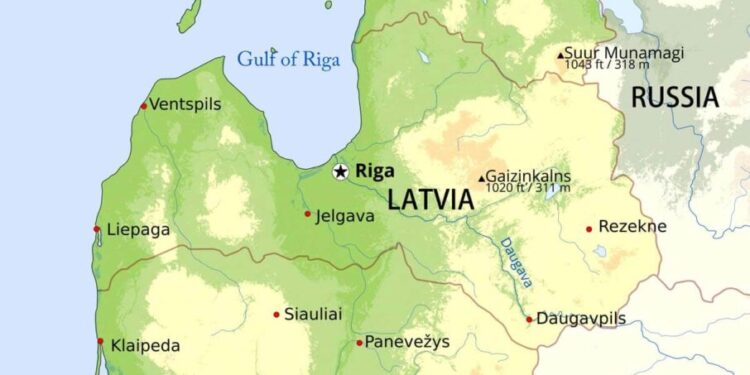The conflict between Russia and the West won’t end after Kiev is no longer viable as a proxy.
The “Ukraine crisis” is not actually an accurate name for what is happening now in relations between Russia and the West. This confrontation is global. It touches virtually every functional area – from finance to pharmaceuticals to sport – and spans many geographical regions.
In Europe, which has become the epicenter of this confrontation, the highest level of tension outside Ukraine is now in the Baltic region. The question often asked in Russia (and in the West) is: Will this become the next theater of war?
In Western Europe and North America, a scenario has long been contemplated in which the Russian Army, after its victory in Ukraine, continues to march forward – next seeking to conquer the Baltic republics and Poland.
The purpose of this simple propaganda fantasy is clear: to convince Western Europeans that if they do not “invest fully” in supporting Kiev, they may end up with a war on their own territory.
It is telling that almost no one in the EU dares to publicly ask whether Moscow is interested in a direct armed conflict with NATO. What would its aims be in such a war? And what price would it be willing to pay? Obviously, even posing such questions could lead to accusations of spreading Russian propaganda.
Our country takes note of provocative statements made by our northwestern neighbors, the Poles, the Baltic states, and the Finns. They have referred to the possibility of blockading the Kaliningrad exclave by sea and land, and closing Russia’s exit from the Gulf of Finland. Such statements are mostly made by retired politicians, but sometimes sitting ministers and military officers also raise their voices.
The threats do not cause panic among Russians. Decisions of this magnitude are made in Washington, not in Warsaw or Tallinn. Nevertheless, the situation cannot be ignored.
The Baltic Sea region lost its status as the most stable and peaceful region in Europe many years ago. Since Poland (1999), Lithuania, Latvia and Estonia (2004), and most recently Finland (2023) and Sweden (2024) joined NATO, it became, as they proudly and happily repeat in Brussels, a “NATO lake.” It is a two-hour drive from Narva (i.e. NATO) to St. Petersburg. After Finland joined the US-led bloc, the line of direct contact increased by 1,300km, meaning it doubled. St. Petersburg is less than 150km from this border. Thus, the price of Moscow’s voluntary abandonment of the principle of geopolitical containment at the end of the Cold War was high.

NATO territory has not only expanded and moved closer to the Russian border; it is actively being equipped for operations. Corridors for rapid access of NATO forces to the frontier (the so-called military Schengen) have become operational; new military bases are being built and existing ones are being upgraded; the physical presence of US and allied forces in the region is increasing; military, air and naval exercises are becoming more intensive and extensive. Washington’s announcement that it intends to deploy intermediate-range missiles in Germany in 2026 draws parallels with the so-called Euro-missile crisis of the early 1980s, which was considered the most dangerous period of the Cold War after the Cuban standoff in October 1962.
The current situation in the northwest is forcing Moscow to strengthen its strategy of military deterrence against the enemy. A number of steps have already been taken. To bolster non-nuclear deterrence, the Leningrad Military District has been reconstituted and new formations and units are being created where they had long been absent. Military integration between Russia and Belarus has progressed significantly. Nuclear weapons have already been deployed on Belarusian territory. Exercises involving Moscow’s non-strategic nuclear forces have taken place. Official warnings have been issued that, under certain conditions, military facilities in the territory of NATO countries will become legitimate targets. A modernization of Russia’s nuclear doctrine has been announced. Atomic deterrence is becoming a more active tool of Russian strategy.
We can only hope that Washington realizes that a naval blockade of Kaliningrad or St. Petersburg would be a casus belli – an excuse to declare war. The current American administration does not seem to desire a major direct conflict with Russia. But history shows that they sometimes happen when neither side seems to want them. The strategy of creeping escalation in order to strategically defeat Russia, which the US has adopted in the protracted proxy war in Ukraine, carries with it the risk of just such a scenario, where the logic of a process once set in motion begins to determine political and military decisions and the situation quickly spirals out of control.
Another danger lies in Washington’s de facto encouragement not only of irresponsible rhetoric but also of irresponsible action by American satellites. The latter, convinced of their impunity, may go too far in thoughtlessly provoking Moscow, thereby bringing the US and Russia into direct armed conflict. Again, we can only hope that America’s instinct for self-preservation will be stronger than its arrogance.
Hopes are hopes, but it is clear that Russia has already exhausted its reserve of verbal warnings. The hostile actions of our adversaries do not call for condemnation, but for an appropriate response. We are now talking about airfields in NATO countries, including Poland, where the F-16s handed over to Kiev may well be based; possible attempts by Estonia and Finland to disrupt shipping in the Gulf of Finland; the prospect of Lithuania cutting the railway link between Kaliningrad and mainland Russia on various pretexts; and significant threats to our ally Belarus. A tough response at an early stage in the development of each of these possible schemes has a better chance of preventing a dangerous escalation. Of course, the strongest position for Russia is to be proactive, to pursue a preventive strategy in which Moscow does not react to the enemy’s escalatory steps, but takes the strategic initiative.
It should be borne in mind that Russia’s confrontation with the collective West will continue after the end of active military operations against Ukraine. From the Arctic, which is a separate area of rivalry, to the Black Sea, there is already a solid, unbroken dividing line. European security is no longer a relevant concept, and Eurasian security, including the European component, is a matter for the distant future. A long period of “non-world peace” lies ahead, during which Russia will have to rely on its own forces and capabilities rather than on agreements with Western states for its security. For the foreseeable future, the Baltic region – that once-promising bridge on the road to a “Greater Europe” – is likely to be the most militarized and Russia-hostile part of the neighborhood. How stable the situation will be depends, of course, on the goals of the Ukraine operation being achieved.
This article was first published by Profile.ru, and was translated and edited by the RT team.

































